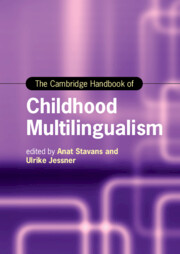Book contents
- The Cambridge Handbook of Childhood Multilingualism
- Cambridge Handbooks in Language and Linguistics
- The Cambridge Handbook of Childhood Multilingualism
- Copyright page
- Contents
- Figures
- Tables
- About the Editors
- Contributors
- Acknowledgments
- Multilingualism Is Not Bilingualism +1: An Introduction
- Part One Becoming and Being a Multilingual Child
- Part Two Cognition and Faculties in Multilinguals
- Part Three Family Language Policy
- Part Four Language(s) and Literacy of Multilingual Children through Schooling
- Part Five Socialization in Childhood Multilingualism
- 21 Building a Plurilingual Identity
- 22 Multilingual Parenting in the United States: Language, Culture and Emotion
- 23 The Development of the Heritage Language in Childhood Bi-/Multilingualism
- 24 Social Cohesion and Childhood Multilingualism in South Africa
- 25 Growing Up in Multilingual Societies: Violations of Linguistic Human Rights in Education
- Part Six Multilingual Children’s Landscape
- Subject Index
- Country Index
- Language Index
- References
25 - Growing Up in Multilingual Societies: Violations of Linguistic Human Rights in Education
from Part Five - Socialization in Childhood Multilingualism
Published online by Cambridge University Press: 18 August 2022
- The Cambridge Handbook of Childhood Multilingualism
- Cambridge Handbooks in Language and Linguistics
- The Cambridge Handbook of Childhood Multilingualism
- Copyright page
- Contents
- Figures
- Tables
- About the Editors
- Contributors
- Acknowledgments
- Multilingualism Is Not Bilingualism +1: An Introduction
- Part One Becoming and Being a Multilingual Child
- Part Two Cognition and Faculties in Multilinguals
- Part Three Family Language Policy
- Part Four Language(s) and Literacy of Multilingual Children through Schooling
- Part Five Socialization in Childhood Multilingualism
- 21 Building a Plurilingual Identity
- 22 Multilingual Parenting in the United States: Language, Culture and Emotion
- 23 The Development of the Heritage Language in Childhood Bi-/Multilingualism
- 24 Social Cohesion and Childhood Multilingualism in South Africa
- 25 Growing Up in Multilingual Societies: Violations of Linguistic Human Rights in Education
- Part Six Multilingual Children’s Landscape
- Subject Index
- Country Index
- Language Index
- References
Summary
Children grow up in societies varying on a continuum between monolingualism and multilingualism. Children from Indigenous/Tribal, Minority and Minoritized communities are subjected to the processes of discrimination and stigmatisation of their languages, and glorification of more dominant languages. The processes of development of childhood multilingualism and multilingual socialisation are discussed in the context of multilingual and relatively monolingual societies. Developmental stages and strategies in multilingual socialisation are discussed to show the complexities in the relationship between multilingual orientation of societies and formal educational practices. We discuss how schools as social power instruments perpetuate inequality and discrimination and violate linguistic human rights of children. Social practices and State (and local) policies in education often promote linguistic homogenisation and loss of childhood multilingualism, leading to (linguistic) genocide in education. In conclusion, the chapter reflects on the meaning and implications of growing up in a multilingual world, and how implementation of children’s LHR can develop and maintain/revitalise multilingualism.
Keywords
- Type
- Chapter
- Information
- The Cambridge Handbook of Childhood Multilingualism , pp. 578 - 602Publisher: Cambridge University PressPrint publication year: 2022
References
- 1
- Cited by



